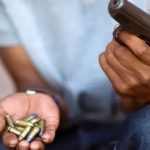Another police sergeant has fallen, and a dangerous name is back on the streets. In the space of a day, three officers died in two provinces. At the center of this story is a trial prisoner awaiting trial – Jabulani Moyo – who is an illegal foreigner from Zimbabwe. Moyo, an extremely dangerous criminal, slipped out of custody during a routine transfer and left two seasoned detectives dead in Roodepoort, west of JOHANNESBURG. Hours later, in a separate case in Schoemansdal, a uniformed officer responding to a business break-in never made it home. As the country tries to make sense of these events, a second thread is unfolding at the highest levels of the police: a wave of claims that the national commissioner, General Fannie Masemola, may soon face arrest over corruption charges. On the ground, teams are hunting armed suspects. At the top, lawyers and investigators are circling. Between those two worlds lies a hard question: who is holding the line, and who is crossing it? Let's delve deeper into today's strange story and I will explain everything in detail for you.
It all started early on Friday in Roodepoort, west of JOHANNESBURG. Two experienced detectives from the Florida police station, Warrant Officer Vuyisile Sintwa, aged 51 with 23 years in uniform, and Sergeant Simon Masenye, aged 45 with 17 years of service, were tasked with a simple but high-risk duty. They were transporting an awaiting trial prisoner, Moyo, who was facing charges for business robbery. According to investigators, the detectives were traveling in an unmarked Toyota Corolla sedan. During the trip, they stopped at a filling station. Somewhere between the court, that stop, and the road back to the cells, the plan collapsed. Moyo is said to have ambushed them, overpowered them, and shot them. Their firearms were taken, and the same weapon is believed to have been used in the attack.
Within minutes, Moyo was seen driving away in that unmarked police Toyota Corolla. The car was later found abandoned a few kilometers from the scene. He vanished into the city, police say, armed with a state-issued pistol, described as determined and ready to do anything to keep his freedom. The questions began immediately. Was he handcuffed? Why was a high-risk prisoner in a sedan instead of the back of a secure van? Why stop for fuel or supplies in the middle of a transfer? Police leadership has told the public that these details are now under formal investigation, and that standard procedure is to restrain prisoners and place them in the back of a secure vehicle. The Hawks are leading the inquiry into every gap that allowed this escape and the double killing. Investigators are collecting CCTV, calling on witnesses from the filling station, and tracing the route from the Roodepoort court to the point of attack.
By the next day, the toll on the service grew heavier. In Mpumalanga, at Schoemansdal, 47-year-old Sergeant Lawrence Mtshweni was part of a team that responded to a business break-in at the Usave shopping center. He was shot during the response and died on scene. He had spent 18 years in the service, attached to visible policing, the unit that shows up first when alarms ring and doors are pried open in the night. Police say at least ten suspects are being pursued for that incident. The service is offering a cash reward of R150,000 for information that leads to their arrest. A separate R150,000 reward has been put up for information on Moyo’s location. A dedicated task team—drawing from Crime Intelligence, detectives, Gauteng tracking teams, and the Hawks—is hunting him across multiple provinces. A key contact has been named for tip-offs: Warrant Officer Rabosiwana from the Hawks at 072 844 4442. Officials stress that Moyo is armed and extremely dangerous, and the public should not approach him.
Within 24 hours, three officers were gone in two provinces. The number is not just a statistic. The men left families and children. They were breadwinners, mentors, and colleagues. According to the service, 27 officers died in the line of duty in the last financial year. From April to now, six more have been lost to sudden attacks and ambushes. Senior leadership has visited the families and promised support with funeral arrangements and all the practical burdens that follow a death on duty. Inside the service, the message is blunt: officers must protect themselves when the threat is immediate, and use their issued tools and training. The leadership speaks of proportional force and the duty to act when lives are in danger, but also of following procedure to the letter when transporting high-risk detainees. It is a balance that is easy to write in a manual and hard to manage in a real street with a real gun pointed back at you.
As the manhunt gathered pace, a different case drew public attention. In Limpopo, at Nkuna Kraal Mall in Nkuzana village, a domestic dispute between two police sergeants ended in tragedy. The woman, attached to the Beitbridge port of entry, was out shopping with her six-year-old child and two other adults. Her estranged husband, a member of the Thohoyandou K9 Unit, confronted her in the parking area. The situation spiraled. He fired his service weapon at her, and she died at the scene. When he tried to flee to his vehicle, bystanders chased him, assaulted him, and set him alight next to the car. The vehicle burned too. He died there. Police registered two murder cases, and provincial leadership condemned the mob action, urging communities to report crimes and let formal processes run. The story added to a weekend already loaded with grief and hard questions: about officer wellness, about how quickly family disputes can turn deadly, and about the dangers when crowds take the law into their own hands.
Back in Gauteng and Mpumalanga, detectives tightened the net. Forensic teams examined the abandoned Corolla. Camera footage from the filling station and nearby routes was pulled. Traffic and neighborhood footage in Roodepoort was scanned for the suspect’s movement. At the court, procedures were reviewed: who checked the restraints, which officers signed the handover, what route was planned, and why a stop happened with a high-risk detainee in custody. In Schoemansdal, the focus turned to syndicate patterns around business burglaries and the Usave break-in. The suspects are believed to be part of a group familiar with the area, and police say the multi-disciplinary team is cross-referencing recent thefts and break-ins for leads. The two cases are not connected, but together they paint a rough picture: organized criminals emboldened in one province, and a ruthless escapee loose in another.
Then, a twist that touches the very top. Over the same weekend, several publications, unnamed sources, and WhatsApp messages circulated claims that the Investigating Directorate Against Corruption (IDAC) had obtained a warrant to arrest National Police Commissioner General Fannie Masemola. The allegations do not relate to the killings or the manhunt. They center on a series of property deals allegedly done through Crime Intelligence funding outside normal procurement rules. At the core are two purchases in September last year: the Kyalami Lodge in Midrand, a 75-bedroom property with ensuite bathrooms, acquired for a figure reported at R48,250,000 including R8,000,000 in transfer costs, and the Veroz Boutique Hotel in Pretoria North, a 23-room venue with a presidential suite, reported at around R34,400,000 including R4,500,000 in transfer costs. Other reports cite different valuations, with one source listing the lodge closer to R40,250,000 before add-ons, and another placing Veroz as high as R43,400,000. The variation has raised eyebrows.
According to these claims, the purchases were approved swiftly by Lieutenant General Dumisani Khumalo, then head of Crime Intelligence, with a global deviation that bypassed the Department of Public Works procurement route. The funds are alleged to have come from the secret service account, a pot commonly described as a slush fund, which receives more than R600 million a year to support intelligence operations, including payments to informants.
Investigators are said to be looking at whether the Treasury and the Auditor-General were notified within the required time after such approvals. Links to earlier arrests of senior Crime Intelligence figures are being drawn by commentators, and one prominent whistleblower’s investigation has questioned the commissioner’s personal finances, suggesting property holdings across several cities that do not align with his reported net salary after deductions. None of these claims have yet been tested in court.
On the record, the official line from IDAC is that the directorate does not discuss ongoing investigations or comment on WhatsApp messages. The SAPS spokesperson has stated that the service is not aware of any warrant for the commissioner, and questions should be directed at IDAC. The commissioner himself has offered no comment beyond telling reporters to ask those who claim a warrant exists. Political figures have publicly said a warrant was ready and that its execution had been delayed for reasons they link to internal battles in the security cluster. They point to a press briefing by the KwaZulu-Natal provincial commissioner, who recently raised concerns about political interference in police operations, and suggest the timing of that briefing changed the pace of events. Analysts say that if an arrest of the national commissioner were to happen, it would likely trigger more suspensions and reveal deeper procurement problems within the service.
The stakes could not be higher. On the ground, officers are chasing a man who shot two detectives, and a group of suspects who gunned down a crime prevention officer at a shopping center. At the same time, the leadership is trying to convince the country that the institution remains steady, even as headlines predict an imminent arrest at the very top. Every gap in procedure is under the microscope. Was the unmarked sedan an acceptable choice for this transfer? Should high-risk detainees ever be moved without a secure van, more escorts, and a pre-cleared route with no public stops? Why did a car carrying a dangerous detainee stop at a garage at all? These are practical questions as much as they are accountability questions. They are about training, resourcing, and judgment in the moment.
Families are mourning. The service has promised to carry the costs that follow duty deaths, to support the children and spouses left behind, and to offer counseling and resources to colleagues who now must return to the streets that took their friends. The leadership has urged officers to use their issued tools when the threat is clear and immediate, but also to plan tightly so that those moments are less likely to arise. Investigators say they are following every lead in the Roodepoort escape, and the Mpumalanga burglary case remains a priority with a dedicated team chasing the ten suspects.
As for Moyo, his description has been circulated widely. He is believed to be moving between known contacts and unfamiliar hideouts, changing transport and routes often. Police have warned residents not to harbor him. The R150,000 reward for information leading to his capture stands, and the number for tips through the Hawks has been shared. Officers say they will not rest until he is found. What do you think could have really happened at the garage, that led to the death of two veteran police officers, and the dramatic escape of Jabulani Moyo?

Follow Us on Twitter










